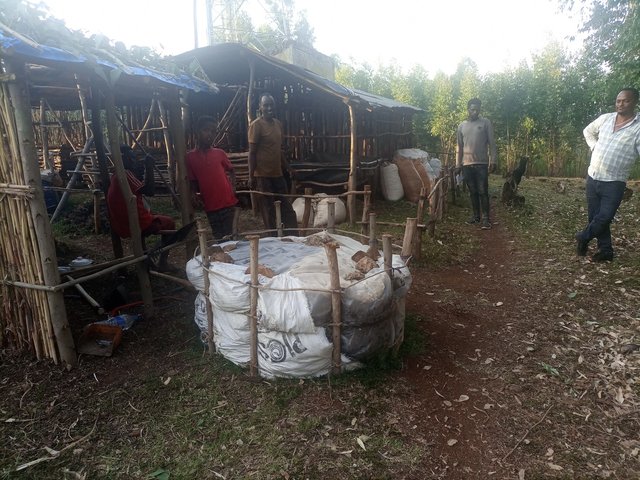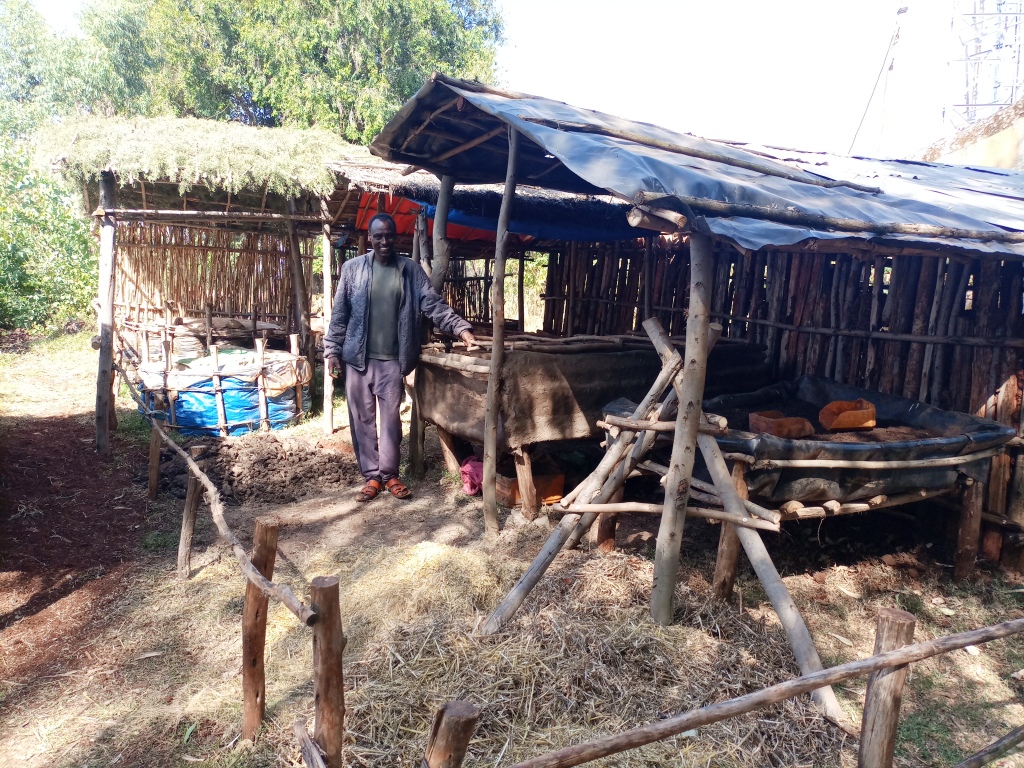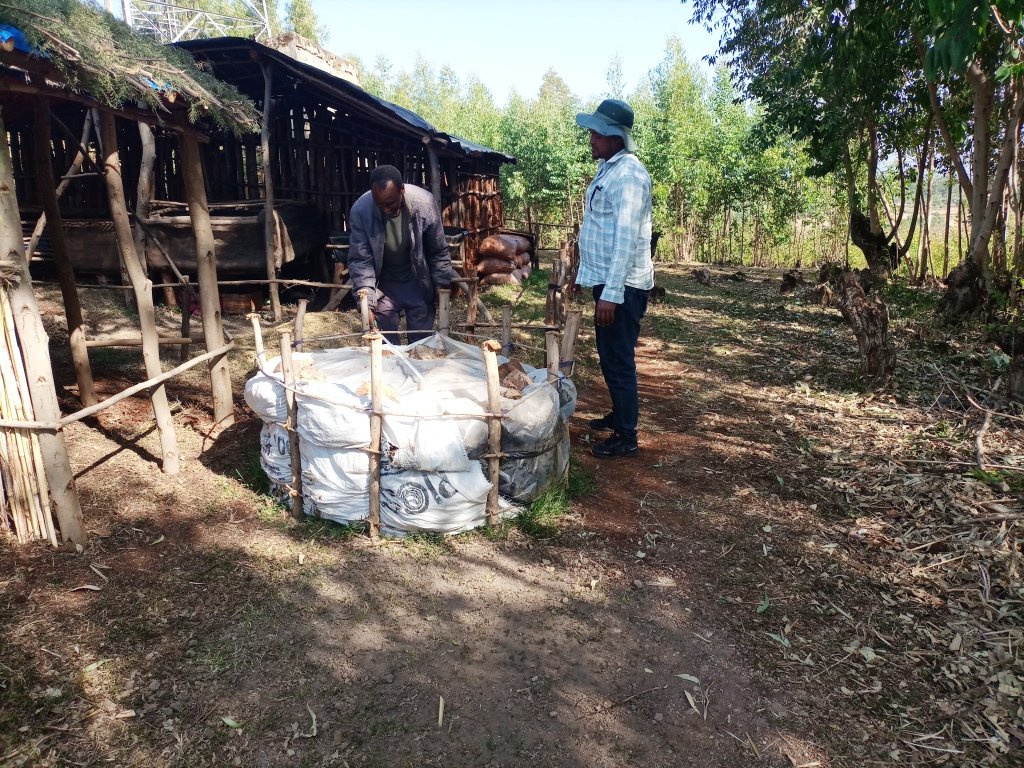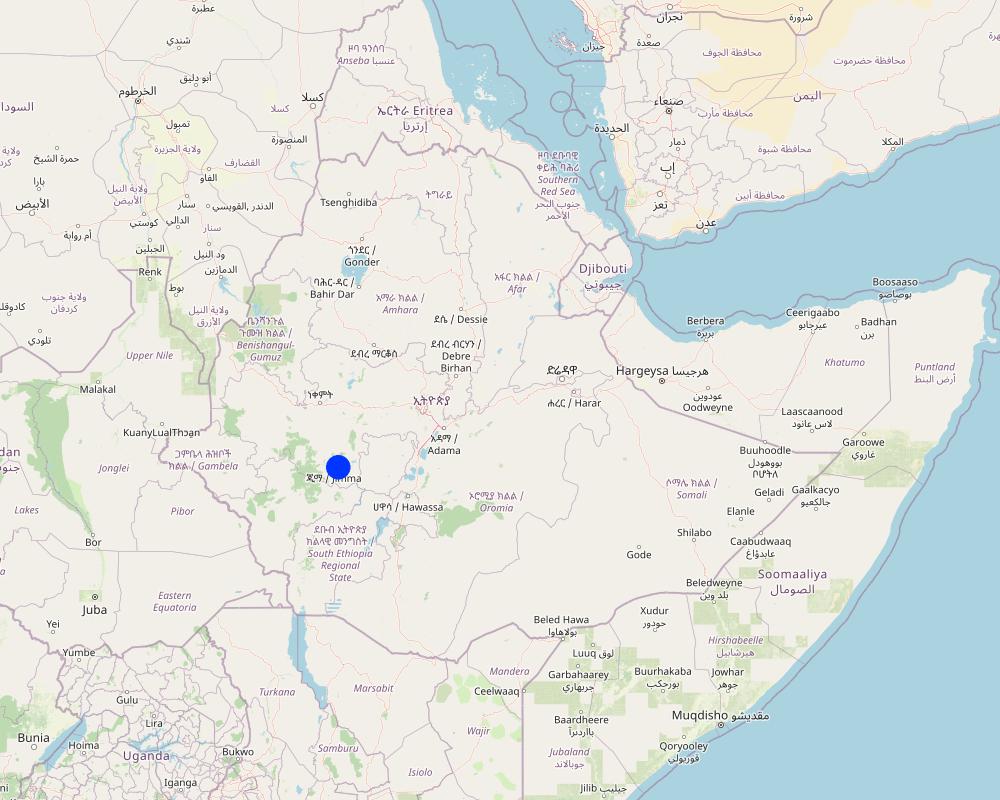Improved Compost [เอธิโอเปีย]
- ผู้สร้างสรรค์:
- การอัพเดท:
- ผู้รวบรวม: GERBA LETA
- ผู้เรียบเรียง: Noel Templer, Julia Doldt, Kidist Yilma, Tabitha Nekesa, Ahmadou Gaye, Siagbé Golli
- ผู้ตรวจสอบ: William Critchley, Rima Mekdaschi Studer, Sally Bunning
Kompoosti Fooyya'a
technologies_6649 - เอธิโอเปีย
ดูส่วนย่อย
ขยายทั้งหมด ย่อทั้งหมด1. ข้อมูลทั่วไป
1.2 รายละเอียดที่ติดต่อได้ของผู้รวบรวมและองค์กรที่เกี่ยวข้องในการประเมินและการจัดเตรียมทำเอกสารของเทคโนโลยี
วิทยากรหลัก
ผู้ใช้ที่ดิน:
Abdulqadir Mohammed
Farmer
เอธิโอเปีย
ชื่อของโครงการซึ่งอำนวยความสะดวกในการทำเอกสารหรือการประเมินเทคโนโลยี (ถ้าเกี่ยวข้อง)
Soil protection and rehabilitation for food security (ProSo(i)l)ชื่อขององค์กรซึ่งอำนวยความสะดวกในการทำเอกสารหรือการประเมินเทคโนโลยี (ถ้าเกี่ยวข้อง)
Alliance Bioversity and International Center for Tropical Agriculture (Alliance Bioversity-CIAT) - เคนยา1.3 เงื่อนไขการใช้ข้อมูลที่ได้บันทึกผ่านทาง WOCAT
ผู้รวบรวมและวิทยากรหลักยอมรับเงื่อนไขเกี่ยวกับการใช้ข้อมูลที่ถูกบันทึกผ่านทาง WOCAT:
ใช่
1.4 การเปิดเผยเรื่องความยั่งยืนของเทคโนโลยีที่ได้อธิบายไว้
เทคโนโลยีที่ได้อธิบายไว้นี้เป็นปัญหาของความเสื่อมโทรมโทรมของที่ดินหรือไม่ จึงไม่ได้รับการยอมรับว่าเป็นเทคโนโลยีเพื่อการจัดการที่ดินอย่างยั่งยืน:
ไม่ใช่
แสดงความคิดเห็น:
The technology is very friendly to SLM since it restores soil fertility and improves the chemical, physical and biological properties of the soil.
1.5 Reference to Questionnaire(s) on SLM Approaches (documented using WOCAT)

Soil Fertility Improvement Cluster [เอธิโอเปีย]
The Soil Fertility Improvement Cluster approach engages five or more farmers living in a village who share skills and labour to prepare and use improved compost as well as to demonstrate it to non-member of the group.
- ผู้รวบรวม: GERBA LETA
2. การอธิบายลักษณะของเทคโนโลยี SLM
2.1 การอธิบายแบบสั้น ๆ ของเทคโนโลยี
คำจำกัดความของเทคโนโลยี:
Improved compost making using “static pile” systems transforms organic material from plants and/or animals into high-value, rich organic compost. It demands less labour, and less time to reach maturity than conventional systems as it thoroughly mixes the ingredients at the beginning which precludes the need to turn the heap later.
2.2 การอธิบายแบบละเอียดของเทคโนโลยี
คำอธิบาย:
Improved composting using static pile systems transforms organic material from plants and/or animals into high-value, rich organic compost. This compost can be prepared in a heap form, where the ingredients are thoroughly mixed and wrapped within a polyethylene sheet. Notably, white polyethylene has the role of intercepting sunlight and improving the solarization effects on weed seeds or wild species arbitrarily used as biomass for improved compost production. This technique accelerates the breakdown of the organic materials faster because it heats up the compost as part of the decomposition process. Accordingly, the compost reaches maturity in 60-70 days. Compost provides the crop with balanced nutrients and helps to increase the soil's organic matter content. It has long‐term, and short‐term effects on plant nutrition as nutrients are continuously released. It is an organic matter resource with the unique ability to improve soils' chemical, physical and biological properties. Improved compost is applied in rows for vegetables and small cereal crops but spot application (planting holes) is employed for large cereal crops such as maize. The application is on an incremental basis year and again to reach out to the large size of lands. In principle, as the nutrients are slowly released, they may not need a continuous application like chemical fertilizers.
Improved compost-making requires 12-15 wooden pegs 1m high each supported by horizontal bars/string, to form a round structure. The interior is lined with plastic sheeting, then thoroughly mixed ingredients, including coffee hulls, ash, livestock manure, crop residues, livestock urine, water, and chaff are mixed and piled before being sealed in the structure. Unlike the mainstream heaps or pits types of composting, it doesn’t need turning. Therefore, this technique reduces labour requirement, and is liked by the users who have been piloting the technology. The relatively short maturity date also enables it to be produced at least twice a year during the offseason. Compost is prepared around the homestead – which allows closer attention - using livestock urine, manure, and house refuse.
In most of Ethiopia's central and western highlands, soil degradation is a severe issue. Soil acidity has become a growing problem challenging the livelihoods of smallholders. Thus, countering the negative effect of degradation and acidity through producing and using organic fertilizers is a key strategy. However, it is essential that the resources of biomass, family labour, skills and motivation, are combined to ensure sustainable land for crop production. From end users' observations and analysis, improved compost restores soil fertility. It increases yield as well as grain quality: this has been proved by testing the grain compared with the harvest where only chemical fertilizers have been applied. Farmers prefer the simplicity of preparing improved compost to the conventional method, and appreciate its role in improving yield and grain quality as well as reducing the labour demand.
2.3 รูปภาพของเทคโนโลยี
คำอธิบายภาพ:
The photo portrays the farmer measuring the total area (by cubic meters) where the improved compost is piled.
2.4 วีดีโอของเทคโนโลยี
ความคิดเห็น/อธิบายสั้นๆ:
Video of the technology is not recorded.
2.5 ประเทศภูมิภาค หรือสถานที่ตั้งที่เทคโนโลยีได้นำไปใช้และได้รับการครอบคลุมโดยการประเมินนี้
ประเทศ:
เอธิโอเปีย
ภูมิภาค/รัฐ/จังหวัด:
Oromia
ข้อมูลจำเพาะเพิ่มเติมของสถานที่ตั้ง :
Babo kebele of Kersa district, Jimma zone
ระบุการกระจายตัวของเทคโนโลยี:
- ใช้ ณ จุดที่เฉพาะเจาะจงหรือเน้นไปยังบริเวณพื้นที่ขนาดเล็ก
Is/are the technology site(s) located in a permanently protected area?
ไม่ใช่
Map
×2.6 วันที่การดำเนินการ
ระบุปีที่ใช้:
2022
2.7 คำแนะนำของเทคโนโลยี
ให้ระบุว่าเทคโนโลยีถูกแนะนำเข้ามาอย่างไร:
- ด้วยการริเริ่มของผู้ใช้ที่ดินเอง
- ทางโครงการหรือจากภายนอก
ความคิดเห็น (ประเภทของโครงการ เป็นต้น) :
Improved compost preparation was introduced by local NGOs known as FC Ethiopia that arranged experience exchange visits to a few farmers in the Arsi Zone of Oromia. A proactive farmer inspired by the technology outdid what he had observed during his visit. He continued inspiring the surrounding community by preparing improved compost with rich ingredients and early maturing capacity compared to conventional compost production.
3. การจัดประเภทของเทคโนโลยี SLM
3.1 วัตถุประสงค์หลักของเทคโนโลยี
- ปรับปรุงการผลิตให้ดีขึ้น
- ลด ป้องกัน ฟื้นฟู การเสื่อมโทรมของที่ดิน
- อนุรักษ์ระบบนิเวศน์
- รักษาสภาพหรือปรับปรุงความหลากหลายทางชีวภาพ
- สร้างผลกระทบทางด้านเศรษฐกิจที่เป็นประโยชน์
3.2 ประเภทของการใช้ที่ดินในปัจจุบันที่ได้นำเทคโนโลยีไปใช้
Land use mixed within the same land unit:
ไม่ใช่

พื้นที่ปลูกพืช
- การปลูกพืชล้มลุกอายุปีเดียว
- การปลูกพืชยืนต้นที่ไม่มีเนื้อไม้
- การปลูกไม้ยืนต้น ไม้พุ่ม
Annual cropping - Specify crops:
- cereals - wheat (spring)
- cereals - maize
- legumes and pulses - beans
- Hot pepper
Perennial (non-woody) cropping - Specify crops:
- banana/plantain/abaca
- sugar cane
Tree and shrub cropping - Specify crops:
- avocado
จำนวนของฤดูเพาะปลูกต่อปี:
- 1
Is intercropping practiced?
ใช่
If yes, specify which crops are intercropped:
Haricot beans with maize
Is crop rotation practiced?
ใช่
ถ้าใช่ ระบุ:
Maize rotate by wheat and then faba beans.
3.3 Has land use changed due to the implementation of the Technology?
Has land use changed due to the implementation of the Technology?
- No (Continue with question 3.4)
3.4 การใช้น้ำ
การใช้น้ำของที่ดินที่มีการใช้เทคโนโลยีอยู่:
- จากน้ำฝน
แสดงความคิดเห็น:
Sources of water supply for improved compost making can be steams or groundwater. However, the compost can be applied to both the rainfed or irrigated agriculture.
3.5 กลุ่ม SLM ที่ตรงกับเทคโนโลยีนี้
- การจัดการปลูกพืชร่วมกับปศุสัตว์
- การจัดการความอุดมสมบรูณ์ของดินแบบผสมผสาน
3.6 มาตรการ SLM ที่ประกอบกันเป็นเทคโนโลยี

มาตรการจัดการพืช
- A2: อินทรียวัตถุในดิน/ความอุดมสมบูรณ์ในดิน
- A3: การรักษาหน้าดิน
A3: Differentiate tillage systems:
A 3.3: Full tillage (< 30% soil cover)

มาตรการอนุรักษ์ด้วยการจัดการ
- M2: การเปลี่ยนแปลงของการจัดการหรือระดับความเข้มข้น
- M5: การควบคุมหรือการเปลี่ยนแปลงขององค์ประกอบของชนิดพันธุ์
แสดงความคิดเห็น:
Applying organic fertilizer to the farm stimulates the regeneration of the lost wild species on the farm.
3.7 รูปแบบหลักของการเสื่อมโทรมของที่ดินที่ได้รับการแก้ไขโดยเทคโนโลยี

การกัดกร่อนของดินโดยน้ำ
- Wt (Loss of topsoil): การสูญเสียดินชั้นบนหรือการกัดกร่อนที่ผิวดิน

การเสื่อมโทรมของดินทางด้านเคมี
- Cn (Fertility decline): ความอุดมสมบูรณ์และปริมาณอินทรียวัตถุในดินถูกทำให้ลดลงไป (ไม่ได้เกิดจากสาเหตุการกัดกร่อน)
- Ca (Acidification): การเกิดกรด

การเสื่อมโทรมของดินทางด้านกายภาพ
- Ps (Subsidence of organic soils): การยุบตัวของดินอินทรีย์ การทรุดตัวของดิน

การเสื่อมโทรมของดินทางด้านชีวภาพ
- Bc (Reduction of vegetation cover): การลดลงของจำนวนพืชที่ปกคลุมดิน
- Bh (Loss of habitat): การสูญเสียแหล่งที่อยู่
- Bs (Quality and species composition): องค์ประกอบหรือความหลากหลายทางคุณภาพและชนิดพันธุ์ลดลง
- Bl (Loss of soil life): การสูญเสียสิ่งมีชีวิตในดิน

การเสื่อมโทรมของน้ำ
- Hs (Change in quantity of surface water): การเปลี่ยนแปลงปริมาณของน้ำที่ผิวดิน
- Hp (Decline of surface water quality): การลดลงของคุณภาพน้ำที่ผิวดิน
3.8 การป้องกัน การลดลง หรือการฟื้นฟูความเสื่อมโทรมของที่ดิน
ระบุเป้าหมายของเทคโนโลยีกับความเสื่อมโทรมของที่ดิน:
- ลดความเสื่อมโทรมของดิน
- ฟื้นฟูบำบัดที่ดินที่เสื่อมโทรมลงอย่างมาก
แสดงความคิดเห็น:
The production and use of organic fertilizer improve soil fertility, regenerates lost species, and improve plant and animal biodiversity. Compost improves the vigorous growth of the crop, plant colour, and crop production. It also improves the rooting system, extends the grain filling period by about 20 days compared to the plot with chemical fertilizers, increases the number of ears/plants and seeds per ear in maize, etc.
4. ข้อมูลจำเพาะด้านเทคนิค กิจกรรมการนำไปปฏิบัติใช้ ปัจจัยนำเข้า และค่าใช้จ่าย
4.1 แบบแปลนทางเทคนิคของเทคโนโลยี
ข้อมูลจำเพาะด้านเทคนิค (แบบแปลนทางเทคนิคของเทคโนโลยี):
Picture that clearly describe the technology is affixed. Detail description is available under the description.
4.2 ข้อมูลทั่วไปเกี่ยวกับการคำนวณปัจจัยนำเข้าและค่าใช้จ่าย
ให้ระบุว่าค่าใช้จ่ายและปัจจัยนำเข้าได้รับการคำนวณอย่างไร:
- ต่อหน่วยเทคโนโลยี
โปรดระบุหน่วย:
Compost production structure
Specify dimensions of unit (if relevant):
6-7m3
อื่นๆ หรือสกุลเงินประจำชาติ (ระบุ):
ETB
If relevant, indicate exchange rate from USD to local currency (e.g. 1 USD = 79.9 Brazilian Real): 1 USD =:
53.12
ระบุค่าเฉลี่ยของค่าจ้างในการจ้างแรงงานต่อวัน:
100
4.3 กิจกรรมเพื่อการจัดตั้ง
| กิจกรรม | Timing (season) | |
|---|---|---|
| 1. | Select site and constructing the structure. | During the off-season particularly right after harvest when adequate biomass is available. |
| 2. | Collecting ingredients for compost making. | During crop harvest |
| 3. | Thoroughly combine the ingredients and seal. | After materials are ready to make the heap. |
| 4. | Harvest/open and dry the compost on open air. | Six to seven weeks after piling the compost. |
4.4 ค่าใช้จ่ายของปัจจัยนำเข้าที่จำเป็นสำหรับการจัดตั้ง
| ปัจจัยนำเข้า | หน่วย | ปริมาณ | ค่าใช้จ่ายต่อหน่วย | ค่าใช้จ่ายทั้งหมดต่อปัจจัยนำเข้า | %ของค่าใช้จ่ายที่ก่อให้เกิดขึ้นโดยผู้ใช้ที่ดิน | |
|---|---|---|---|---|---|---|
| แรงงาน | Labor | PDs | 5.0 | 100.0 | 500.0 | 100.0 |
| อุปกรณ์ | Spade | number | 1.0 | 300.0 | 300.0 | |
| อุปกรณ์ | Reck | number | 1.0 | 160.0 | 160.0 | 100.0 |
| อุปกรณ์ | Machete | number | 1.0 | 1000.0 | 1000.0 | 100.0 |
| อุปกรณ์ | Sickle | number | 1.0 | 500.0 | 500.0 | 100.0 |
| วัสดุสำหรับก่อสร้าง | Posts for peg making | number | 2.0 | 50.0 | 100.0 | 100.0 |
| วัสดุสำหรับก่อสร้าง | Horizontal bars | number | 5.0 | 10.0 | 50.0 | 100.0 |
| วัสดุสำหรับก่อสร้าง | Strings | meter | 12.0 | 10.0 | 120.0 | 100.0 |
| วัสดุสำหรับก่อสร้าง | Polyethylene sheet | meter | 14.0 | 50.0 | 700.0 | 100.0 |
| ค่าใช้จ่ายทั้งหมดของการจัดตั้งเทคโนโลยี | 3430.0 | |||||
| Total costs for establishment of the Technology in USD | 64.57 | |||||
ถ้าผู้ใช้ที่ดินรับภาระน้อยกว่า 100% ของค่าใช้จ่าย ให้ระบุว่าใครเป็นผู้รับผิดชอบส่วนที่เหลือ:
So far, the district/Woreda Office of Agriculture covered the cost of the spade for participating model farmers in the training as an incentive.
แสดงความคิดเห็น:
Cost of making or producing the technology is largely covered by the land users themselves. District SLM experts provide technical support and monitoring the land users activities on irregular basis. It is only the labor cost and some expendable supplies that are demanded every other time. Otherwise, materials are reused for the perpetuation of compost production.
4.5 การบำรุงรักษาสภาพหรือกิจกรรมที่เกิดขึ้นเป็นประจำ
แสดงความคิดเห็น:
Essentially, improved compost making does not need visible maintenance work. Rather it aspires collection of inputs or materials to perpetuate production of compost. Such activities can be considered as recurrent activities that ensure compost production on sustainable basis.
4.6 ค่าใช้จ่ายของปัจจัยนำเข้าและกิจกรรมที่เกิดขึ้นเป็นประจำที่ต้องการการบำรุงรักษา (ต่อปี)
| ปัจจัยนำเข้า | หน่วย | ปริมาณ | ค่าใช้จ่ายต่อหน่วย | ค่าใช้จ่ายทั้งหมดต่อปัจจัยนำเข้า | %ของค่าใช้จ่ายที่ก่อให้เกิดขึ้นโดยผู้ใช้ที่ดิน | |
|---|---|---|---|---|---|---|
| แรงงาน | Labor | PDs | 5.0 | 100.0 | 500.0 | 100.0 |
| วัสดุสำหรับก่อสร้าง | Plastic sheet | meter | 14.0 | 50.0 | 700.0 | 100.0 |
| วัสดุสำหรับก่อสร้าง | Posts | number | 2.0 | 50.0 | 100.0 | 100.0 |
| ค่าใช้จ่ายทั้งหมดของการบำรุงรักษาสภาพเทคโนโลยี | 1300.0 | |||||
| Total costs for maintenance of the Technology in USD | 24.47 | |||||
แสดงความคิดเห็น:
The estimated cost is only to construct one structure that allows the preparation of about 6-7 m3 of compost. If a farmer wants to produce as much compost as possible simultaneously, the material and labor demand can be doubled or quadrupled.
4.7 ปัจจัยสำคัญที่สุดที่มีผลกระทบต่อค่าใช้จ่าย
ปัจจัยสำคัญที่สุดที่มีผลกระทบต่อค่าใช้จ่ายต่างๆ:
Material prices are also variable because of economic instability and price fluctuation. In general, the cost is inconsistent because of inflation.
5. สิ่งแวดล้อมทางธรรมชาติและของมนุษย์
5.1 ภูมิอากาศ
ฝนประจำปี
- < 250 ม.ม.
- 251-500 ม.ม.
- 501-750 ม.ม.
- 751-1,000 ม.ม.
- 1,001-1,500 ม.ม.
- 1,501-2,000 ม.ม.
- 2,001-3,000 ม.ม.
- 3,001-4,000 ม.ม.
- > 4,000 ม.ม.
ข้อมูลจำเพาะ/ความคิดเห็นเรื่องปริมาณน้ำฝน:
The site receives high rainfall in summer maximum (June to September). From January to May, it is the dry season with short showers in March/April.
ระบุชื่อของสถานีตรวดวัดอากาศที่ใช้อ้างอิงคือ:
Jimma
เขตภูมิอากาศเกษตร
- กึ่งชุ่มชื้น
5.2 สภาพภูมิประเทศ
ค่าเฉลี่ยความลาดชัน:
- ราบเรียบ (0-2%)
- ลาดที่ไม่ชัน (3-5%)
- ปานกลาง (6-10%)
- เป็นลูกคลื่น (11-15%)
- เป็นเนิน (16-30%)
- ชัน (31-60%)
- ชันมาก (>60%)
ธรณีสัณฐาน:
- ที่ราบสูง/ที่ราบ
- สันเขา
- ไหล่เขา
- ไหล่เนินเขา
- ตีนเนิน
- หุบเขา
ระดับความสูง:
- 0-100 เมตร
- 101-500 เมตร
- 501-1,000 เมตร
- 1,001-1,500 เมตร
- 1,501-2,000 เมตร
- 2,001-2,500 เมตร
- 2,501-3,000 เมตร
- 3,001-4,000 เมตร
- > 4,000 เมตร
ความคิดเห็นและข้อมูลจำเพาะเพิ่มเติมเรื่องสภาพภูมิประเทศ:
Topography (5.2) does not define improved compost as a practice/technology. The above questions are addressed merely to describe the site where the technology was applied. The technology can be applied in diverse landforms or slopes as long as necessary ingredients and issues that call for mitigation are experienced.
5.3 ดิน
ค่าเฉลี่ยความลึกของดิน:
- ตื้นมาก (0-20 ซ.ม.)
- ตื้น (21-50 ซ.ม.)
- ลึกปานกลาง (51-80 ซ.ม.)
- ลึก (81-120 ซ.ม.)
- ลึกมาก (>120 ซ.ม.)
เนื้อดิน (ดินชั้นบน):
- ปานกลาง (ดินร่วน ทรายแป้ง)
เนื้อดินล่าง (> 20 ซ.ม.ต่ำจากผิวดิน):
- ปานกลาง (ดินร่วน ทรายแป้ง)
อินทรียวัตถุในดิน:
- ต่ำ (<1%)
(ถ้ามี) ให้แนบคำอธิบายเรื่องดินแบบเต็มหรือระบุข้อมูลที่มีอยู่ เช่น ชนิดของดิน ค่า pH ของดินหรือความเป็นกรดของดิน ความสามารถในการแลกเปลี่ยนประจุบวก ไนโตรเจน ความเค็ม เป็นต้น:
The soil types is Nitosol and soil pH is about 5 on average.
5.4 ความเป็นประโยชน์และคุณภาพของน้ำ
ระดับน้ำใต้ดิน:
5-50 เมตร
น้ำไหลบ่าที่ผิวดิน:
ดี
คุณภาพน้ำ (ที่ยังไม่ได้บำบัด):
เป็นน้ำเพื่อการดื่มที่ดี
Water quality refers to:
surface water
ความเค็มของน้ำเป็นปัญหาหรือไม่:
ไม่ใช่
5.5 ความหลากหลายทางชีวภาพ
ความหลากหลายทางชนิดพันธุ์:
- ปานกลาง
ความหลากหลายของแหล่งที่อยู่:
- ปานกลาง
ความคิดเห็นและข้อมูลจำเพาะเพิ่มเติมของความหลากหลายทางชีวภาพ:
There is declining biodiversity because of the increasing degradation of the soil.
5.6 ลักษณะของผู้ใช้ที่ดินที่นำเทคโนโลยีไปปฏิบัติใช้
อยู่กับที่หรือเร่ร่อน:
- อยู่กับที่
แนวทางการตลาดของระบบการผลิต:
- mixed (subsistence/ commercial)
รายได้ที่มาจากนอกฟาร์ม:
- < 10% ของรายได้ทั้งหมด
ระดับของความมั่งคั่งโดยเปรียบเทียบ:
- รวย
เป็นรายบุคคล/ครัวเรือน:
- เป็นรายบุคคล/ครัวเรือน
ระดับของการใช้เครื่องจักรกล:
- การใช้กำลังจากสัตว์
เพศ:
- ชาย
อายุของผู้ใช้ที่ดิน:
- วัยกลางคน
5.7 Average area of land used by land users applying the Technology
- < 0.5 เฮกตาร์
- 0.5-1 เฮกตาร์
- 1-2 เฮกตาร์
- 2-5 เฮกตาร์
- 5-15 เฮกตาร์
- 15-50 เฮกตาร์
- 50-100 เฮกตาร์
- 100-500 เฮกตาร์
- 500-1,000 เฮกตาร์
- 1,000-10,000 เฮกตาร์
- >10,000 เฮกตาร์
พิจารณาว่าเป็นขนาดเล็ก กลาง หรือขนาดใหญ่ (ซึ่งอ้างอิงถึงบริบทระดับท้องถิ่น):
- ขนาดเล็ก
5.8 กรรมสิทธิ์ในที่ดิน สิทธิในการใช้ที่ดินและสิทธิในการใช้น้ำ
กรรมสิทธิ์ในที่ดิน:
- รัฐ
- รายบุคคล ได้รับสิทธิครอบครอง
สิทธิในการใช้ที่ดิน:
- รายบุคคล
สิทธิในการใช้น้ำ:
- เข้าถึงได้แบบเปิด (ไม่ได้จัดระเบียบ)
Are land use rights based on a traditional legal system?
ไม่ใช่
ระบุ:
He accessed land redistribution through the local government.
5.9 การเข้าถึงบริการและโครงสร้างพื้นฐาน
สุขภาพ:
- จน
- ปานกลาง
- ดี
การศึกษา:
- จน
- ปานกลาง
- ดี
ความช่วยเหลือทางด้านเทคนิค:
- จน
- ปานกลาง
- ดี
การจ้างงาน (เช่น ภายนอกฟาร์ม):
- จน
- ปานกลาง
- ดี
ตลาด:
- จน
- ปานกลาง
- ดี
พลังงาน:
- จน
- ปานกลาง
- ดี
ถนนและการขนส่ง:
- จน
- ปานกลาง
- ดี
น้ำดื่มและการสุขาภิบาล:
- จน
- ปานกลาง
- ดี
บริการด้านการเงิน:
- จน
- ปานกลาง
- ดี
แสดงความคิดเห็น:
As the farmland is closer to all-weather roads and the district town, the farmer can easily access almost all of the facilities in the area.
6. ผลกระทบและสรุปคำบอกกล่าว
6.1 ผลกระทบในพื้นที่ดำเนินการ (On-site) จากการใช้เทคโนโลยี
ผลกระทบทางด้านเศรษฐกิจและสังคม
การผลิต
การผลิตพืชผล
จำนวนก่อน SLM:
2 tons/hectare
หลังจาก SLM:
2.8 tons/hectare
แสดงความคิดเห็น/ระบุ:
Maize yield has immensely increased during the first harvest with compost as compared to the plot with NSP fertilizer at the rate of 100 kg/ha. As nutrients from organic fertilizers gradually available, it is expected to increase in the coming years.
คุณภาพพืชผล
แสดงความคิดเห็น/ระบุ:
Land users communicated the positive effects of using compost on grain size and overall quantity of production.
การผลิตพืชที่ใช้เลี้ยงปศุสัตว์
แสดงความคิดเห็น/ระบุ:
As biomass production is increasing, the part of crop residue that is used for livestock feed is also increasing.
ความหลากหลายของผลิตภัณฑ์
การจัดการที่ดิน
แสดงความคิดเห็น/ระบุ:
Farmlands where improved compost applied increases soil aggregate stability as compared to the farmland where only chemical fertilizers is applied.
รายได้และค่าใช้จ่าย
ค่าใช่จ่ายของปัจจัยการผลิตทางการเกษตร
แสดงความคิดเห็น/ระบุ:
Using organic fertilizer (improved compost) reduces land users investment on chemical fertilizers.
รายได้จากฟาร์ม
แสดงความคิดเห็น/ระบุ:
It correlates with increasing production per unit of land.
ความหลากหลายของแหล่งผลิตรายได้
แสดงความคิดเห็น/ระบุ:
The farmer also generate income from the sale of compost itself.
ผลกระทบด้านสังคมวัฒนธรรมอื่น ๆ
ความมั่นคงด้านอาหาร / พึ่งตนเองได้
สถานการณ์ด้านสุขภาพ
แสดงความคิดเห็น/ระบุ:
Convergent to food and nutrition security.
สถาบันของชุมชน
แสดงความคิดเห็น/ระบุ:
Farmer group formation is promoted for peer learning.
ผลกระทบด้านนิเวศวิทยา
วัฐจักรน้ำหรือน้ำบ่า
ปริมาณน้ำ
คุณภาพน้ำ
แสดงความคิดเห็น/ระบุ:
Ground cover contributes to filtering the downslope runoff and siltation.
น้ำไหลบ่าที่ผิวดิน
การระบายน้ำส่วนเกิน
แสดงความคิดเห็น/ระบุ:
The organic matter in the improved compost improve soil structure and simplify water drainage down in soil horizon.
ดิน
ความชื้นในดิน
สิ่งปกคลุมดิน
แสดงความคิดเห็น/ระบุ:
Improved compost increase biomass production and soil cover.
การสูญเสียดิน
การสะสมของดิน
การเกิดแผ่นแข็งที่ผิวดิน /การเกิดชั้นดาน
แสดงความคิดเห็น/ระบุ:
Improved compost promotes soil aggregate stability.
การอัดแน่นของดิน
การหมุนเวียนและการเติมของธาตุอาหาร
อินทรียวัตถุในดิน/ต่ำกว่าดินชั้น C
แสดงความคิดเห็น/ระบุ:
Salinity is uncommon in the district.
ความเป็นกรด
ความหลากหลายทางชีวภาพของพืชและสัตว์
การปกคลุมด้วยพืช
มวลชีวภาพ/เหนือดินชั้น C
ความหลากหลายทางชีวภาพของพืช
แสดงความคิดเห็น/ระบุ:
Compost promotes the growth of wild species and/or promotes the succession of some lost species.
ความหลากหลายทางชีวภาพของสัตว์
ชนิดพันธุ์ที่ให้ประโยชน์
ความหลากหลายของสัตว์
การจัดการศัตรูพืชและโรคพืช
ลดความเสี่ยงของภัยพิบัติ
ผลกระทบจากภัยแล้ง
การปล่อยคาร์บอนและก๊าซเรือนกระจก
แสดงความคิดเห็น/ระบุ:
It increases surface and subsurface biomass production and sequester soil carbon.
ภูมิอากาศจุลภาค
Specify assessment of on-site impacts (measurements):
Quantifying the positive or negative effects of technology demands the documentation of different facets of the technology which is virtually lacking. In most cases, farmer's responses and expert's opinions were used to addressing the comprehensive questions in the questionnaire.
6.2 ผลกระทบนอกพื้นที่ดำเนินการ (Off-site) จากการใช้เทคโนโลยี
น้ำที่ใช้ประโยชน์ได้
แสดงความคิดเห็น/ระบุ:
Slightly increases as it improves the soil infiltration potential.
การไหลของน้ำคงที่และสม่ำเสมอในช่วงฤดูแล้ง
น้ำท่วมพื้นที่ท้ายน้ำ
การทับถมของดินตะกอนพื้นที่ท้ายน้ำ
แสดงความคิดเห็น/ระบุ:
It positively associate with reduction of the runoff due to good ground cover.
การเกิดมลพิษในน้ำบาดาลหรือแม่น้ำ
ผลกระทบของก๊าซเรือนกระจก
แสดงความคิดเห็น/ระบุ:
Such impact can be achieved in the long-term.
Specify assessment of off-site impacts (measurements):
Improving soil fertility increases biodiversity and reduces multiple adverse effects of degradation on the environment.
6.3 การเผชิญและความตอบสนองของเทคโนโลยีต่อการเปลี่ยนแปลงสภาพภูมิอากาศที่ค่อยเป็นค่อยไป และสภาพรุนแรงของภูมิอากาศ / ภัยพิบัติ (ที่รับรู้ได้โดยผู้ใช้ที่ดิน)
การเปลี่ยนแปลงสภาพภูมิอากาศที่ค่อยเป็นค่อยไป
การเปลี่ยนแปลงสภาพภูมิอากาศที่ค่อยเป็นค่อยไป
| ฤดู | increase or decrease | เทคโนโลยีมีวิธีการรับมืออย่างไร | |
|---|---|---|---|
| อุณหภูมิประจำปี | เพิ่มขึ้น | ปานกลาง | |
| อุณหภูมิตามฤดูกาล | ฤดูแล้ง | เพิ่มขึ้น | ดีมาก |
ผลลัพธ์ตามมาที่เกี่ยวข้องกับภูมิอากาศอื่น ๆ
ผลลัพธ์ตามมาที่เกี่ยวข้องกับภูมิอากาศอื่น ๆ
| เทคโนโลยีมีวิธีการรับมืออย่างไร | |
|---|---|
| ช่วงการปลูกพืชที่ขยายออกไป | ดีมาก |
6.4 การวิเคราะห์ค่าใช้จ่ายและผลประโยชน์ที่ได้รับ
ผลประโยชน์ที่ได้รับเปรียบเทียบกับค่าใช้จ่ายในการจัดตั้งเป็นอย่างไร (จากมุมมองของผู้ใช้ที่ดิน)
ผลตอบแทนระยะสั้น:
ด้านบวกเล็กน้อย
ผลตอบแทนระยะยาว:
ด้านบวก
ผลประโยชน์ที่ได้รับเปรียบเทียบกับค่าใช้จ่ายในการบำรุงรักษาหรือต้นทุนที่เกิดขึ้นซ้ำอีก เป็นอย่างไร (จากมุมมองของผู้ใช้ที่ดิน)
ผลตอบแทนระยะสั้น:
ด้านบวกเล็กน้อย
ผลตอบแทนระยะยาว:
ด้านบวก
แสดงความคิดเห็น:
The benefits accrued from the application of technology (improved compost) increases overtime as the rate of nutrient adsorption or release of the elements is on a gradual basis as compared to chemical fertilizers. The return remains positive despite variations in temporal and the degrees.
6.5 การปรับตัวของเทคโนโลยี
- 1-10%
ถ้ามีข้อมูลให้บอกปริมาณด้วย (จำนวนของครัวเรือนหรือครอบคลุมพื้นที่):
About five farmers were adopted in one village. It is spreading in a similar manner over the other areas.
Of all those who have adopted the Technology, how many did so spontaneously, i.e. without receiving any material incentives/ payments?
- 91-100%
แสดงความคิดเห็น:
So far, the farmer is adopting through advisory services and familiarization with the technology via exchange visits. However, the visited farmer increased the number of ingredients used as feedstock for compost production compared to what he had seen during his visit to the Arsi zone of Oromia.
6.6 การปรับตัว
เทคโนโลยีได้รับการปรับเปลี่ยนเมื่อเร็วๆนี้ เพื่อให้ปรับตัวเข้ากับสภาพที่กำลังเปลี่ยนแปลงหรือไม่:
ไม่ใช่
6.7 จุดแข็ง / ข้อได้เปรียบ / โอกาสของเทคโนโลยี
| จุดแข็ง / ข้อได้เปรียบ / โอกาสในทัศนคติของผู้ใช้ที่ดิน |
|---|
| Improve soil fertility and reduce acidity on gradual basis. |
| Increase grain and biomass yield and quality of the crop. |
| Generate income from the sale of compost. |
| จุดแข็ง / ข้อได้เปรียบ / โอกาสในทัศนคติของผู้รวบรวมหรือวิทยากรหลัก |
|---|
| It reduces the investment cost on chemical fertilizers. |
| Shortly mature compared to conventional compost making, enabling more composts to be produced. |
| It reduces labor costs as an overturning operation is exempted. |
6.8 จุดอ่อน / ข้อเสียเปรียบ / ความเสี่ยงของเทคโนโลยีและวิธีการแก้ไข
| จุดอ่อน / ข้อเสียเปรียบ / ความเสี่ยงในทัศนคติของผู้ใช้ที่ดิน | มีวิธีการแก้ไขได้อย่างไร |
|---|---|
| Intensive labour during planting (transport to the farm and implement row or spot application) depending on the crop types. | Promote labour-sharing arrangements with neighboring peers, engage family labor, and use necessary farm tools such as wheelbarrows to transport to the nearby farms. |
| จุดอ่อน / ข้อเสียเปรียบ / ความเสี่ยงในทัศนคติของผู้รวบรวมหรือวิทยากรหลัก | มีวิธีการแก้ไขได้อย่างไร |
|---|---|
| Introduction of the technology is steered by soil fertility improvement department of the district office on piecemeal basis. | Need popularization via the extension system. This demands institutionalizing the technology as the best technology/practice. |
7. การอ้างอิงและการเชื่อมต่อ
7.1 วิธีการและแหล่งข้อมูล
- ไปเยี่ยมชมภาคสนาม การสำรวจพื้นที่ภาคสนาม
Two farmers
- การสัมภาษณ์กับผู้ใช้ที่ดิน
Only a farmer
- การสัมภาษณ์ผู้เชี่ยวชาญด้าน SLM หรือผู้ชำนาญ
Soil fertility improvement process owner.
วันที่เก็บรวบรวมข้อมูล(ภาคสนาม) :
10/02/2023
7.2 การอ้างอิงถึงสิ่งตีพิมพ์
หัวข้อ, ผู้เขียน, ปี, หมายเลข ISBN:
Soil Fertility Management: An introductory Fact-Sheet for Farmers and Projects.Organic Exchange. 2009
ชื่อเรื่อง ผู้เขียน ปี ISBN:
free online
7.3 Links to relevant online information
ชื่อเรื่องหรือคำอธิบาย:
Making and Using Compost for Organic Farming
URL:
https://eorganic.org/node/2880
7.4 General comments
The questionnaire is broad and often goes beyond the general feature of a technology. Of course, strict documentation of the different features of the technology are desirable.
ลิงก์และโมดูล
ขยายทั้งหมด ย่อทั้งหมดลิงก์

Soil Fertility Improvement Cluster [เอธิโอเปีย]
The Soil Fertility Improvement Cluster approach engages five or more farmers living in a village who share skills and labour to prepare and use improved compost as well as to demonstrate it to non-member of the group.
- ผู้รวบรวม: GERBA LETA
โมดูล
ไม่มีโมดูล





